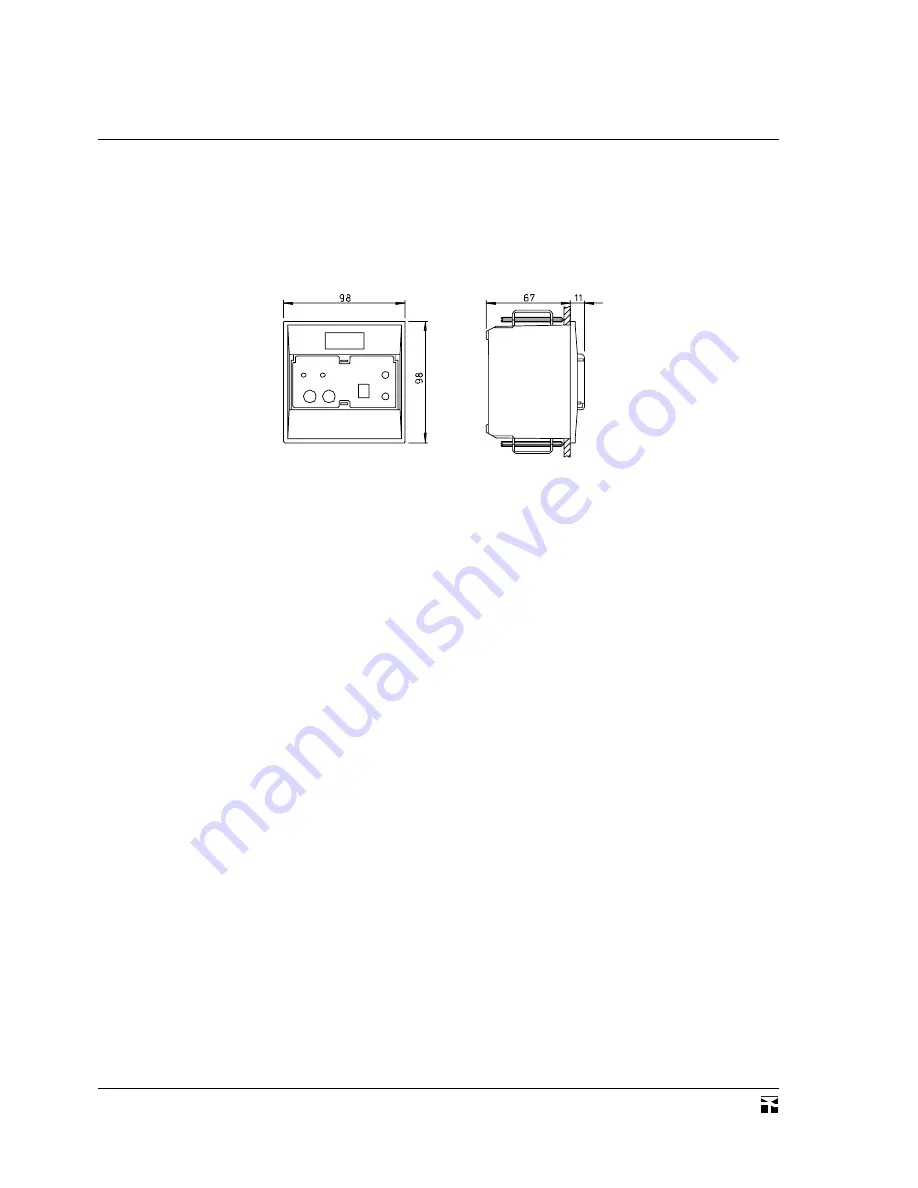
2
031000\08
11-2002
Oltre alla versione normale, è disponibile anche una versione
in cui il relè finale, permanentemente eccitato in condizione
normale, si diseccita in caso d'intervento: si ottiene così l'inter-
vento, a favore della sicurezza, anche in caso di guasto del
dispositivo RMT o in caso di mancanza della tensione ausiliaria.
MODALITÀ PER L'INSTALLAZIONE
Besides the normal version, another version is available in
wich the final relay is permanently energized in the normal
condition and deenergizes in case of operation: so the operation
occurs, to guarantee the safety, also in case of RMT failure or
auxiliary voltage lack.
INSTALLATION MODALITY
Montaggio meccanico
I dispositivi RMT/8D sono
adatti per montaggio incassato;
le dimensioni d'ingombro sono
conformi alle norme DIN.
I trasformatori toroidali sono
dotati di staffa per montaggio a
sbalzo su pannello.
Collegamenti elettrici
I collegamenti elettrici de-
vono essere eseguiti in confor-
Mechanical mounting
The devices RMT/8D are de-
signed for flush mounting; their
dimensions are in accordance
with DIN standards.
The toroidal transformers are
provided with a bracket for a
projecting mounting onto wall.
Electrical connection
Electrical connections must
be made according to the dia-
mità agli schemi d'inserzione rappresentati nella pagina seguente.
CIRCUITO DI ALIMENTAZIONE AUSILIARIA
Il relè necessita di una tensione ausiliaria ai morsetti 6-7
oppure 6-8, come indicato sull'apparecchio stesso. In caso di
alimentazione in corrente continua, la tensione deve essere deri-
vata da una batteria o da un raddrizzatore trifase con ondulazione
massima del 15%. In caso di alimentazione in corrente alternata,
la tensione può essere derivata dalla stessa rete controllata, a
monte del contattore o dell'interruttore automatico associato al
dispositivo RMT, per assicurare la presenza di tensione al circuito
di alimentazione ausiliaria.
Il dispositivo può funzionare con una tensione ausiliaria
avente una tolleranza di ±20 % rispetto al valore nominale
indicato in targa.
CIRCUITO AMPEROMETRICO
Ai morsetti 1-2 sono collegati i conduttori provenienti dai
morsetti di misura del trasformatore toroidale, identificati con
S1-S2.
La sezione dei conduttori deve essere non inferiore a 1 mm
2
e
di lunghezza la più breve possibile (massimo 20 m). I conduttori
non devono essere installati in prossimità di componenti
elettromeccanici o di conduttori di potenza, i quali possono essere
fonte di campi magnetici e di perturbazioni transitorie del segnale
misurato. In caso di elevate induzioni, i conduttori amperometrici
devono essere avvolti tra loro ed eventualmente in esecuzione
schermata, avendo cura di collegare lo schermo al morsetto 1.
CIRCUITO DI RIPRISTINO
Il relè amperometrico è previsto con il pulsante di ripristino
manuale RESET posto sul fronte della custodia; il comando di
ripristino può anche essere rinviato a distanza collegando un
pulsante normalmente aperto ai morsetti 3-4. Per i due conduttori
relativi al comando di ripristino devono essere osservate le
medesime raccomandazioni indicate per il circuito amperometrico.
Effettuando un collegamento permanente ai morsetti 3-4,
oppure posizionando su A il microinterruttore frontale contrasse-
gnato RESET, si ottiene il ripristino automatico, a condizione che
la corrente residua rilevata sia scesa sotto il 95% della soglia
d'intervento.
grams indicated in the following page.
AUXILIARY SUPPLY CIRCUIT
The measuring device requires an auxiliary voltage be applied
at terminals 6-7 or 6-8, as indicated on the case. If the supply is
direct current, the voltage must be derived from a battery or a
three-phase bridge rectifier with a maximum residual ripple of
15%. If the supply is alternating current, the voltage can be
derived from the same line where the device is installed, with a
connection above the contactor or the circuit breaker controlled
by RMT: in this way the supply to the circuit is assured even upon
operation of the device RMT.
The device can work with an auxiliary voltage having a
tolerance of ±20 % with respect to the nominal value indicated on
the case.
CURRENT CIRCUIT
The measuring terminals of the toroidal transformer, indicated
with S1-S2, must be connected to terminals 1-2 of the measuring
relay.
The cross section of the conductors must be not lower than
1 mm
2
and their lenght as short as possible (20 m maximum).
These conductors must not run close to electromechanical com-
ponents or power cables, wich can give rise to magnetic fields or
transient disturbances affecting the measured signal. In the worst
conditions of high magnetic induction, the signal conductors must
be twisted together and possibly shielded, by connecting the
shield to terminal 1.
RESET CIRCUIT
The current measuring relay is provided with a manual RESET
pushbutton located on the front plate; the reset control can also be
remotely operated by connecting a normally open pushbutton to
terminals 3-4. The same recommendations above indicated for
the current measuring circuit also apply for the conductors of the
reset circuit.
By making a solid connection between terminals 3-4, or by
setting to A the front plate microswitch referred to as RESET, the
function of automatic reset is performed, upon condition that the
residual current detected by the device drops below 95% of the
operation threshold.






















